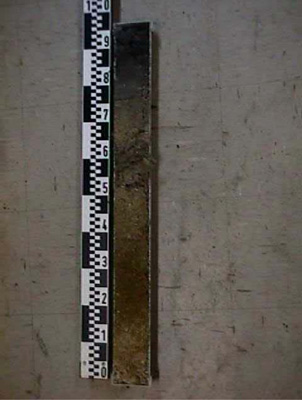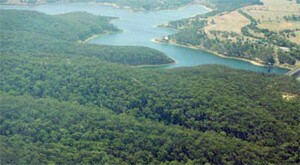BD10
|
| BD10 |  Bleached-sodic, Mesonatric, Yellow Kurosol | |
| Lal Lal | |||
| Low hills | |||
| Ordovician sandstone and shale | |||
| Hillcrest | |||
| 6–8% | |||
Horizon | Depth (cm) | Description | ||
A1 | 0–17 | Dark grey (10YR4/1); loamy sand; weak structure; friable; water repellent; pH 5.0; clear boundary to: | ||
A2 | 17–41 | Pale brown (10YR6/3); loamy sand; apedal massive structure; pH 5.0; clear boundary to: | ||
B2 | 41–100+ | Yellow (10YR7/6); silty clay; apedal massive structure; pH 5.0. | ||
| Management Considerations | ||||
This soil has been considered rather poor for agricultural purposes mainly due to its poor physical structure and low fertility. Most of the area is still under forest or planted to pines. Cereals generally do not grow particularly well because of the poor soil structure and low fertility. However, by improving the fertility with several years under pasture, it is possible to grow reasonable good cereal crops in the drier areas or in the dry years in the wetter areas. When there is enough summer rainfall, or irrigation, summer fodder crops such as rape, turnips, and, in the more fertile paddocks, chou moellier, grow well in this soil. Where there is a good depth of topsoil, potatoes also yield quite well, but they must be harvested early to avoid autumn or winter waterlogging. This soil is best suited to growing pastures, and with present technical knowledge, it is possible to grow very good pastures. This grey or brown Ordovician soil is not suitable for growing lucerne. In the wetter areas, the subsoil becomes too wet in the winter for lucerne, and in the drier areas lucerne cannot develop a deep enough root system due to the nature of the subsoil. | ||||
Analytical data
Site BD10 | Sample depth | pH | EC | NaCl | Ex Ca | Ex Mg | Ex K | Ex Na | Ex Al | Ex Acidity | FC –10kPa | PWP –1500kPa | KS | FS | Z | C | |
Horizon | cm | H2O | CaCl2 | dS/m | % | cmolc/kg | cmolc/kg | cmolc/kg | cmolc/kg | mg/kg | cmolc/kg | % | % | % | % | % | % |
A1 | 0–10 | 4.5 | 3.5 | <0.05 | N/R | 0.48 | 1.1 | 0.21 | 0.24 | 370 | N/R | N/R | N/R | N/R | N/R | N/R | N/R |



